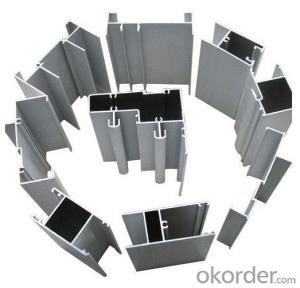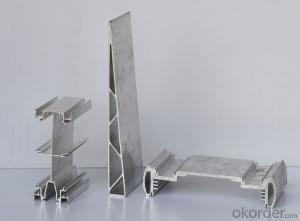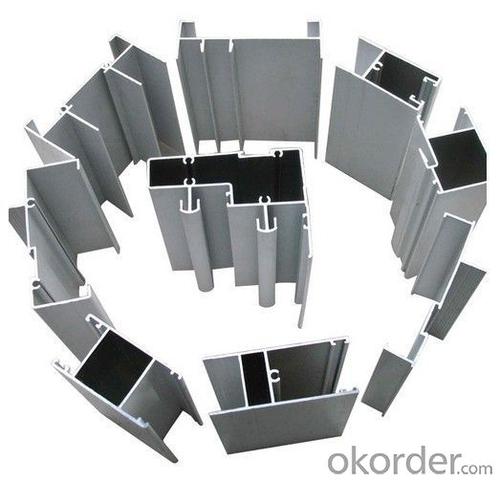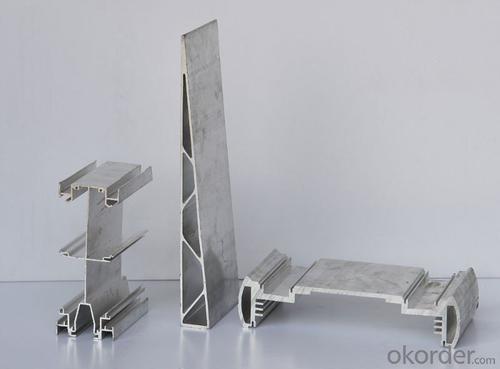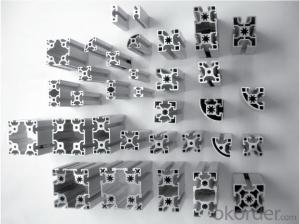Aluminum Profiles - Extruded Aluminum Profiles Made in China Prices
- Loading Port:
- Shanghai
- Payment Terms:
- TT OR LC
- Min Order Qty:
- 1 m.t.
- Supply Capability:
- 1000 m.t./month
OKorder Service Pledge
OKorder Financial Service
You Might Also Like
Specification
1. Specification of Extruded Aluminum Profiles Made in China Prices
Alloy | State | Tensile Strength δbMpa | Non-proportional Stretching Stress(δp0.2Mpa) | Stretching rate (δ%) | Pattern Thickness (mm) | HV | HW |
No Less Than | |||||||
6061 | T4/T6 | 180/265 | 110/245 | 16/8 | - | - | - |
6063 | T5/T6 | 160/205 | 110/180 | 8/8 | 0.8/- | 58/- | 8/- |
6063A | T5/T6 | 200,190/230,220 | 160,150/190,180 | 5,5/5,4 | 0.8,0.8/-,- | 65,65/-,- | 10,10/-,- |
2. Application of Extruded Aluminum Profiles Made in China Prices
wall cladding, ceilings, bathrooms, kitchens and balconies, shutters, doors,windows…
3. Feature of Extruded Aluminum Profiles Made in China Prices
Surface Quality :
Be free from Oil Stain, Dent, Inclusion, Scratches, Stain, Oxide Decoration, Breaks, Corrosion, Roll Marks, Dirt Streaks and other defect which will interfere with use,
Mochenical Property:
Chemical Composite and Mechanical Property
4. Certificate:
SGS and ROHS(if client request, paid by client), MTC(plant provided), Certificate of Origin(FORM A, FORM E, CO), Bureau Veritas and SGS (if client request, paid by client), CIQS certificate
5. Image of Extruded Aluminum Profiles Made in China Prices
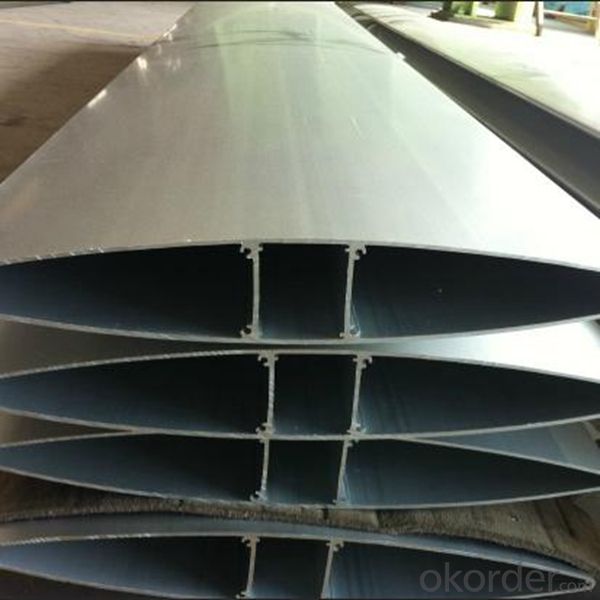
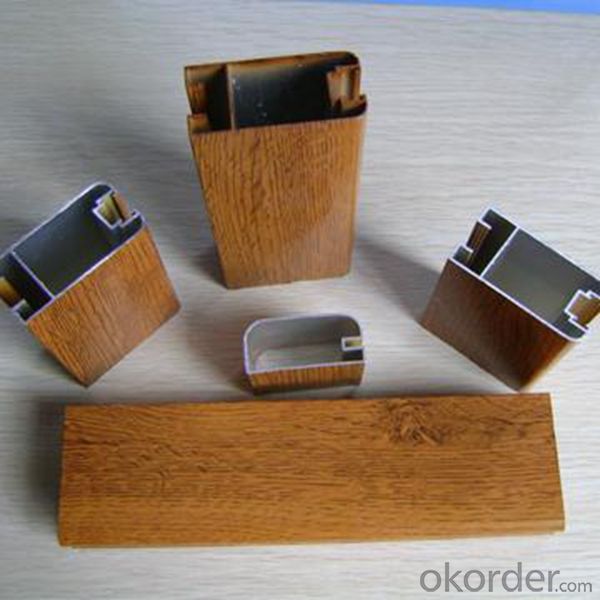
6. Package and shipping of Extruded Aluminum Profiles Made in China Prices
First, plastic cloth with drying agent inside; Second, Pearl Wool; Third, wooden cases with dry agent, fumigation wooden pallets, aluminum surface could cover blue PVC film
7. FAQ
Question 1: What is your MOQ?
We accept one ton per type for an order. But the detail we could negotiate.
Question 2: What is your normal terms of payment?
We always trade with you by T/T. But we also accept the L/C as you require.
Question 3: How many kinds of the surface treatment we can choose?
You could choose different color of powder coated. Anodized of black. matte silver, nature, champagne, bronze color. Mill finished. Wooden finished and printed.etc.
Question 4: Can you supply OEM services?
We offer OEM services for 17 years.
Question 5: How many days for opening the mould?
Normally about 10 days.According to the difficulty of your drawing.
Question 6: Can i choose the package what i want?
Yes, of course. We offer various kinds of package.e.g.PE foam. Shrink film. Wrapping paper.
But we would give you professional suggestion of package.
- Q: This question asks for a list of various types of coatings applied to aluminum profiles to prevent corrosion.
- <p>Aluminum profiles are protected from corrosion through several types of coatings. These include: Anodizing, which forms a protective oxide layer; Powder Coating, a durable and weather-resistant finish; Electrophoretic Deposition (E-coat), offering a smooth, corrosion-resistant surface; Fluoropolymer coatings, known for their exceptional chemical resistance and UV stability; and Thermal Spray Coatings, which provide a hard, wear-resistant surface. Each method serves to enhance the aluminum's resistance to environmental factors and extend its lifespan.</p>
- Q: How do you ensure proper alignment and accuracy when using aluminum profiles?
- To ensure proper alignment and accuracy when using aluminum profiles, several steps can be followed. Firstly, it is crucial to use high-quality aluminum profiles that are manufactured with precision. This ensures that the profiles are straight and have consistent dimensions. Secondly, before assembling the profiles, it is essential to carefully measure and mark the desired positions for joints, holes, or connections. Accurate measurements and markings help in aligning the profiles correctly. Thirdly, using appropriate tools like corner clamps or angle measuring tools can aid in aligning the profiles accurately at the desired angles. These tools help in holding the profiles securely in place during the assembly process. Additionally, using leveling or straight edges can help in ensuring that the profiles are aligned correctly in terms of height or flatness. Regularly checking the alignment during the assembly process and making necessary adjustments is also crucial. Finally, it is essential to follow the manufacturer's guidelines and recommendations for assembly techniques, fasteners, and accessories. Adhering to these instructions ensures that the profiles are accurately aligned and securely fastened, resulting in proper alignment and accuracy.
- Q: How can I distinguish aluminum from aluminium oxide or electrophoresis aluminum or spray aluminium material?
- Spraying aluminum can also increase the thickness of aluminum, but it can be observed under the magnifying glass. The coating on the surface of the electrophoresis aluminum is more dense and tidy
- Q: What are the various energy-saving characteristics that can be incorporated into aluminum profiles?
- <p>Aluminum profiles can incorporate several energy-saving features to enhance thermal insulation and reduce energy consumption. These include: 1. Thermal breaks: Inserts that reduce heat transfer between the interior and exterior of a profile. 2. Multi-chamber designs: Multiple air chambers within the profile that act as insulators. 3. Low-E coatings: Reflective coatings that reduce heat transfer. 4. Insulating glass units: Double or triple glazed units with gas fills that provide superior insulation. 5. Passive solar design: Profiles designed to maximize heat gain in winter and minimize it in summer. 6. High-performance seals: Gaskets and seals that minimize air infiltration. 7. Aerodynamic shapes: Profiles that reduce air resistance and heat loss. These features can significantly contribute to energy efficiency in buildings.</p>
- Q: How do aluminum profiles perform in terms of impact resistance?
- Known for their excellent impact resistance, aluminum profiles are able to withstand significant impact without becoming easily deformed or damaged, thanks to their inherent strength and durability. The ideal strength-to-weight ratio of aluminum makes it particularly suitable for industries such as automotive, aerospace, and construction, where impact resistance is crucial. In addition, the structure of aluminum profiles allows them to absorb and distribute impact energy, thereby preventing localized damage. This property proves especially advantageous in situations that require resistance to sudden shocks, collisions, or heavy loads. Moreover, aluminum profiles can be customized with specific reinforcements or structural elements to further enhance their impact resistance. This flexibility allows for meeting specific requirements or addressing areas prone to impact. In summary, the exceptional impact resistance of aluminum profiles makes them highly valued in industries and applications where strength and durability are essential.
- Q: Light aluminum is what mean?
- Extruded out only through aging treatment, without other surface treatment of aluminum (such as spraying, oxidation and other deep-processing)
- Q: What are the methods to protect aluminum profiles from corrosion during the installation and usage phases?
- <p>To prevent corrosion of aluminum profiles during installation and use, follow these steps: 1. Choose high-quality aluminum profiles with proper alloy composition that resists corrosion. 2. Ensure the surface is clean and free from contaminants before installation. 3. Apply a protective coating such as a clear anodized finish, powder coating, or paint to the aluminum surface. 4. Avoid contact with corrosive substances like saltwater or chemicals. 5. Regularly inspect and clean the profiles to remove dirt and debris that can lead to corrosion. 6. Use stainless steel fasteners and avoid dissimilar metal contact, as it can accelerate corrosion. 7. Maintain a dry environment to prevent moisture-induced corrosion. By following these practices, you can significantly reduce the risk of corrosion and prolong the lifespan of aluminum profiles.</p>
- Q: What are the different assembly options available for aluminum profiles?
- Depending on specific requirements and applications, there are various assembly options available for aluminum profiles. Here are some commonly used methods: 1. For a strong and secure connection that allows frequent disassembly or adjustment, mechanical fastening is preferred. This involves using screws, bolts, or rivets to join aluminum profiles together. 2. When maximum strength and rigidity are needed, welding is an ideal choice. Aluminum profiles can be welded using techniques such as TIG or MIG welding, resulting in a seamless and strong joint. 3. Adhesive bonding is suitable for lightweight applications or when aesthetics are important. It provides a clean and seamless appearance without visible fasteners, although it may not be as strong as mechanical fastening or welding. 4. Aluminum profiles often have T-slot designs that allow the use of connecting elements like T-nuts, connectors, and brackets. These elements can be easily inserted into the slots and tightened to create a secure and adjustable joint, making it useful for flexible and easily reconfigurable applications. 5. Corner brackets are specifically designed to connect aluminum profiles at right angles. They can be easily attached using screws or bolts, providing a strong and rigid joint. They are commonly used in frame construction or for creating corners in structural applications. 6. Some aluminum profiles feature interlocking systems that eliminate the need for additional fasteners or connectors. These systems utilize specially designed shapes or grooves that fit together, ensuring a secure connection. They are often used in modular structures or systems that require quick assembly and disassembly. Ultimately, the choice of assembly method for aluminum profiles depends on factors such as strength requirements, aesthetics, ease of assembly, and the specific application or industry. Careful consideration of these factors is important when selecting the most suitable assembly option for a given project.
- Q: How do aluminum profiles resist corrosion?
- Aluminum profiles resist corrosion due to the formation of a protective oxide layer on their surface. This oxide layer acts as a barrier, preventing any further reaction between the aluminum and the surrounding environment, thus inhibiting corrosion.
- Q: Can aluminum profiles be used in telecommunications infrastructure?
- Telecommunications infrastructure can indeed utilize aluminum profiles. Aluminum, a versatile and lightweight material, boasts numerous benefits in telecommunications applications. It possesses corrosion resistance, making it ideal for outdoor setups exposed to severe weather. Moreover, aluminum profiles are easily fabricated and customizable, allowing for specific requirements like mounting brackets, cable trays, or equipment racks. Additionally, aluminum profiles possess outstanding electrical conductivity, a crucial aspect in telecommunications infrastructure for efficient signal transmission. They find utility in constructing transmission towers, antenna supports, and base stations, serving various purposes. Furthermore, aluminum stands out as a sustainable material, as it can be recycled repeatedly without compromising its properties. This aligns with the growing emphasis on environmental sustainability within the telecommunications industry. To sum up, aluminum profiles present a cost-effective and reliable solution for telecommunications infrastructure, offering durability, flexibility, and exceptional electrical conductivity.
Send your message to us
Aluminum Profiles - Extruded Aluminum Profiles Made in China Prices
- Loading Port:
- Shanghai
- Payment Terms:
- TT OR LC
- Min Order Qty:
- 1 m.t.
- Supply Capability:
- 1000 m.t./month
OKorder Service Pledge
OKorder Financial Service
Similar products
Hot products
Hot Searches
Related keywords
